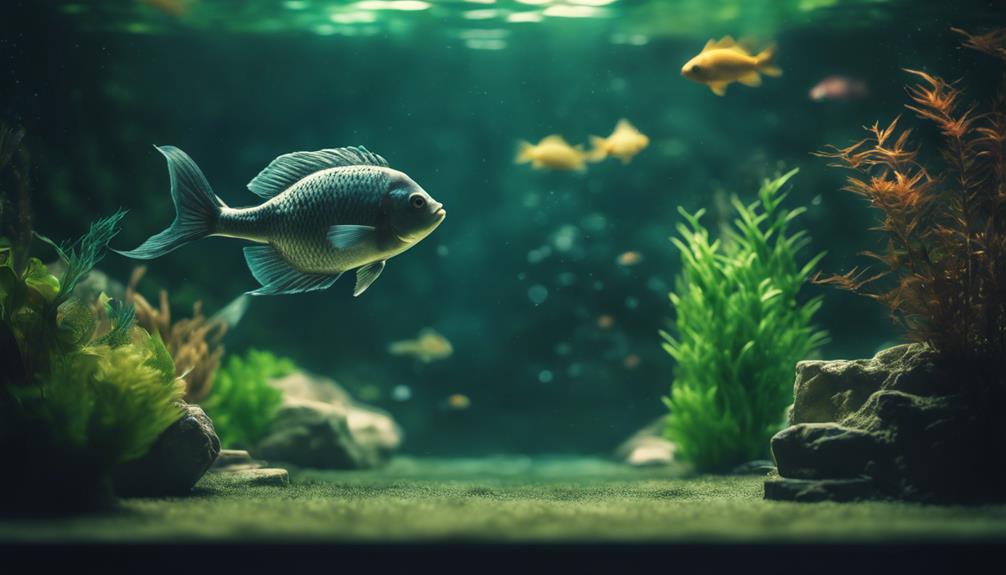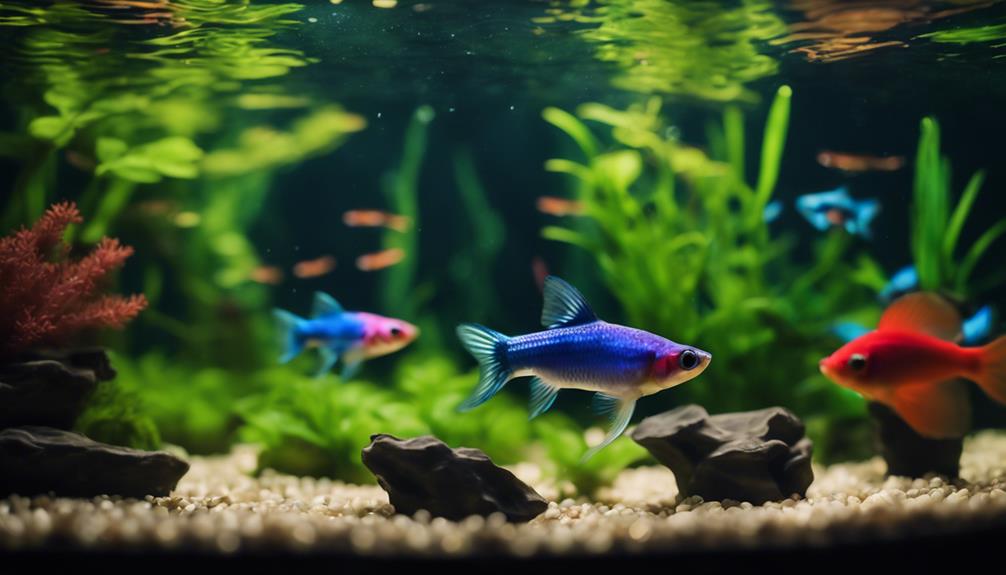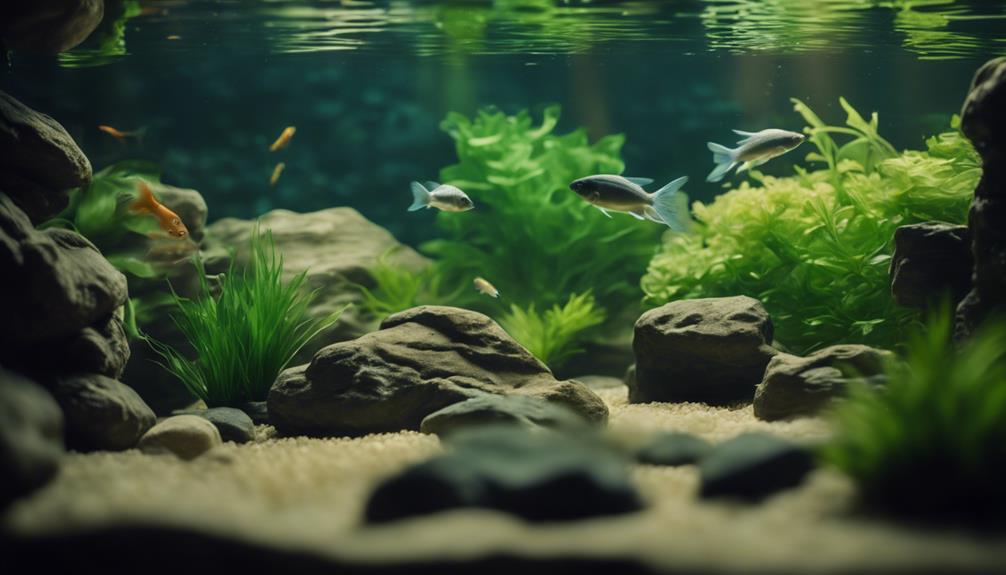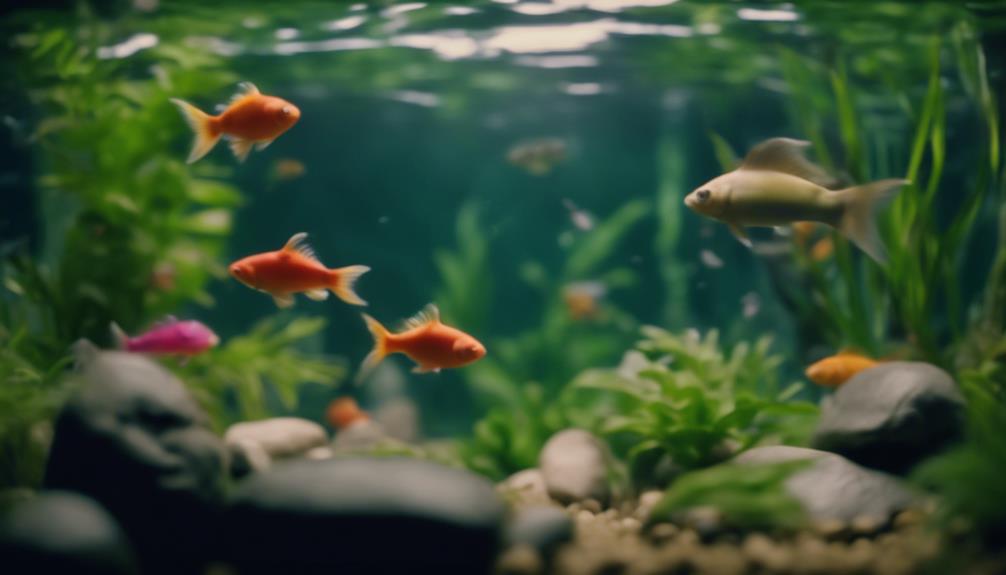You can reduce fish stress naturally by maintaining ideal water quality through regular water changes and monitoring parameters like temperature, ammonia, and nitrate levels. Providing adequate hiding places, avoiding overcrowding and aggression, and establishing a consistent daily routine also help alleviate anxiety. Selecting compatible tank mates, monitoring water parameters closely, and reducing environmental stressors naturally are also key strategies. By implementing these methods, you'll be well on your way to creating a stress-free environment for your fish. Now, discover the specific techniques and tweaks that can make all the difference in your aquatic friends' lives.
Table of Contents
Key Takeaways
- Regular water changes of 25% every 2-3 weeks remove toxins and waste, reducing fish stress and promoting a healthy environment.
- Providing hiding places, such as plants or rocks, gives fish a sense of security and reduces environmental stressors.
- Maintaining a consistent daily routine, including a lighting schedule, feeding, and water changes, creates a predictable and stable environment.
- Ensuring adequate space, at least 1-2 gallons of water per inch of fish, reduces aggression and stress caused by overcrowding.
- Monitoring water parameters, such as pH, ammonia, and nitrate levels, helps identify and address potential stressors, promoting a thriving environment.
Maintaining Optimal Water Quality
By regularly changing the water in your aquarium and monitoring its parameters, you can create a stress-reducing environment for your fish by maintaining ideal water quality.
Regular water changes of at least 25% every 2-3 weeks help remove accumulated toxins and waste products, reducing stress in fish.
It's also essential to monitor water temperatures, ammonia levels, nitrate levels, and other parameters to verify they're within the perfect range for your fish.
A high-quality filtration system, such as a biological filter, can help remove waste products and excess nutrients that can contribute to stress in fish.
Additionally, maintaining adequate dissolved oxygen levels is vital, as low oxygen levels can cause significant stress.
By staying on top of water changes and monitoring water parameters, you can prevent stress and disease in your fish, creating a thriving and healthy environment.
Providing Adequate Hiding Places
When you create a stress-reducing environment for your fish, you're providing them with a sense of security and comfort.
You do this by incorporating hiding places that offer visual barriers, allowing your fish to feel safe and secure without feeling trapped or confined.
Visual Barriers Provided
You can substantially reduce fish stress in your tank by providing adequate hiding places, such as plants, rocks, or other decorations, that give your fish a sense of security and allow them to feel hidden from potential predators. These visual barriers help create a sense of relief from stress, allowing your fish to feel more comfortable in their aquarium environment.
Three key areas to ponder when placing visual barriers are:
- High-traffic areas: Place hiding places near food sources or in areas with strong water currents to provide relief from stress.
- Varied sizes and shapes: Use a mix of sizes and shapes to accommodate different species and sizes of fish.
- Ideal water flow: Guarantee that hiding places don't obstruct water flow or create dead spots in the tank, which can negatively impact superior water quality.
Hiding Places for Fish
Providing adequate hiding places is vital to reducing fish stress, and visual barriers are just the starting point – it's equally important to certify each fish has multiple places to retreat to when feeling threatened or stressed.
You want to guarantee that each of your aquarium fish has at least 2-3 hiding places to call their own, giving them a sense of security and allowing them to escape from predators or aggressive tank mates.
This is especially important for species that are naturally skittish or shy, such as neon tetras or corydoras catfish, which may spend most of their time hiding.
Live plants like anacharis or cabomba can provide additional benefits by maintaining good water quality and offering a natural food source for some fish.
Decorations like treasure chests, sunken ships, or other ornaments can also provide hiding places and add visual interest to the aquarium.
Avoiding Overcrowding and Aggression

To create a harmonious aquarium environment, making room for each species is crucial to prioritize space allocation, as overcrowding can quickly lead to aggression and stress among your finned friends. You want to provide a comfortable and peaceful space for your fish to thrive.
Overcrowding can lead to stress in fish, which can weaken their immune system and make them more susceptible to disease.
Provide adequate space: Aim for at least 1-2 gallons of water per inch of fish to give them room to swim and establish their own territories.
Choose compatible species: Introduce peaceful species that are compatible with each other, avoiding mixing species with different temperaments or territorial instincts.
Maintain a low stocking density: This will help reduce aggression and stress in fish, improve water quality, and reduce the risk of disease outbreaks.
Establishing a Consistent Daily Routine
By sticking to a consistent daily routine, fish can thrive in an environment that's predictable and stable, which greatly reduces their stress levels. You can create a routine that works for you and your fish by incorporating the following elements:
| Task | Frequency | Benefits |
|---|---|---|
| Lighting schedule | Daily | Regulates circadian rhythms, reduces stress |
| Feeding | Daily | Reduces stress and anxiety about food |
| Water changes | Weekly | Maintains good water quality, reduces stress |
| Tank cleaning | Bi-weekly | Removes toxins, reduces stress |
Selecting Compatible Tank Mates

When selecting compatible tank mates, you'll want to choose species that are tolerant of each other's presence and won't engage in aggressive behavior.
Avoid mixing species with a history of aggression or competition, as this can lead to stress and physical harm.
Tolerant Tank Mate Selection
You can substantially reduce fish stress by carefully selecting compatible tank mates that thrive in similar water conditions and exhibit harmonious social behaviors.
This means researching and understanding the social and spatial requirements of different fish species to guarantee a peaceful coexistence.
By selecting species with similar water requirements, such as pH and temperature, you can reduce stress caused by incompatible water conditions.
Avoid mixing species with different temperaments, such as pairing peaceful fish with aggressive or fin-nipping species, to prevent stress and injury.
Introduce species that occupy different swimming levels, such as bottom-dwellers and mid-water swimmers, to reduce competition for space and resources.
Select a limited number of species and confirm adequate space for each fish to reduce stress and territorial behavior.
Avoid Aggressive Species Mixing
Mixing aggressive species in the same tank can be a recipe for disaster, leading to fin nipping, chasing, and territorial behavior that can cause undue stress on your fish.
To avoid this, you should research the social requirements and habitat needs of each species before introducing them to your aquarium. Some fish, like betta fish, cichlids, and angelfish, are naturally aggressive and should be kept separate from peaceful species.
You can also reduce aggression by keeping schooling fish, like neon tetras and harlequin rasboras, in groups of 6-10 or more. This promotes social behavior and reduces stress.
Additionally, avoid mixing species with different swimming levels, such as surface-dwellers and bottom-dwellers, to reduce competition for resources and reduce stress.
By selecting compatible tank mates, you can create a harmonious environment that reduces fish stress. Remember, a stress-free environment is vital for maintaining healthy aquarium water, stable nitrate and ammonia levels, and ideal CO2 levels.
With an Air Pump and regular water changes, you can create a thriving ecosystem where your fish can flourish without the risk of White Spot or other diseases.
Similar Water Requirement Needs
Selecting tank mates with similar water requirement needs is a critical step in reducing fish stress, as incompatible water conditions can lead to severe health problems and even death. When fish are placed in an environment that doesn't meet their water requirements, they might experience stress, which can cause a range of problems, including low oxygen levels and disease.
Avoids water condition conflicts: Fish that require warmer water, for example, shouldn't be placed with those that thrive in cooler temperatures.
Reduces aggression: When fish have similar water needs, they're less likely to compete for resources and defend their territory, reducing aggression and stress.
Prevents health issues: Incompatible water conditions can lead to severe health problems, a sure sign that your fish are stressed. Make sure to research the specific water requirements of each species to create a harmonious and stress-free environment in your aquarium. By doing so, you'll be able to provide your fish with the best possible care, ensuring they thrive and live a healthy life.
Monitoring Water Parameters Closely
Regular monitoring of water parameters is essential to identify potential stressors and prevent fish stress, as even slight changes can have devastating effects on your aquatic friends.
You can't assume your water is safe just because it looks clear – poor water quality can be invisible, yet deadly.
That's why it's pivotal to use a test kit to check pH, ammonia, nitrite, and nitrate levels regularly.
For most freshwater fish, a pH range of 6.5-8.5 is ideal, and sudden changes can be catastrophic.
Ammonia and nitrite levels should always be at 0 ppm, as any amount can cause stress, damage, and even disease.
Nitrate levels, on the other hand, should be kept in check to prevent algae growth and related issues.
By performing regular water changes of 10-20% every week, you can maintain stable water parameters and reduce fish stress.
Remember, it's always better to be proactive than reactive when it comes to your fish's health.
Reducing Environmental Stressors Naturally

By addressing the physical environment of your aquarium, you can substantially reduce environmental stressors that can impact your fish's well-being, and create a more natural and calming space for them to thrive.
As you observe your fish, pay attention to subtle changes in behavior or appearance that may indicate environmental stress. By making a few simple adjustments, you can create a more harmonious environment for your fish to flourish.
Provide hiding places and visual barriers: Add plants, rocks, and driftwood to give your fish a sense of security and comfort.
Maintain a consistent day-night cycle: Simulate natural rhythms with a consistent lighting schedule to help your fish establish a routine.
Rotate or change tank decorations regularly: Stimulate exploration and reduce boredom by changing up the scenery in your tank.
Frequently Asked Questions
How Do You Destress Fish Naturally?
To achieve aquatic calmness, you create fish relaxation through natural sedation by employing water therapy, environmental enrichment, and behavioral modification techniques, incorporating sensory stimulation and gentle handling to soothe your finned friends.
Can Fish Recover From Stress?
You can help your fish recover from stress by identifying stress symptoms, addressing environmental factors, and understanding their unique behavior and personality, allowing them to bounce back from chronic stress within a reasonable recovery time.
What Is Anti Stress Solution for Fish?
You're the captain of your aquatic ship, traversing treacherous waters of fish stress. An anti-stress solution for your finned friends is like dropping anchor in a peaceful cove, combining calming aids like natural remedies, soothing environments, and herbal treatments to create a relaxation haven.
How Do I Make My Fish Less Scared?
To make your fish less scared, you're creating a calming environment by providing gentle handling, a quiet space, soothing decor, and peaceful tankmates.
Conclusion
By implementing these 7 natural stress-reducing methods, you'll create a harmonious environment for your fish to thrive.
Did you know that a staggering 90% of aquarium fish die within the first year due to stress-related illnesses?
By taking proactive steps to minimize stress, you can substantially increase the lifespan and well-being of your aquatic friends.
With a little effort, you can create a peaceful oasis that your fish will love – and live to tell the tale.

